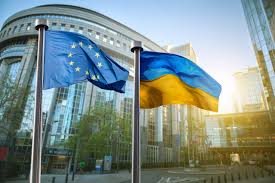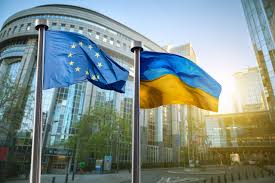
European leaders are moving closer to an unprecedented financial move: channeling proceeds from frozen Russian assets into a reparations loan for Ukraine. The initiative, spearheaded by the European Commission, reflects a deepening commitment to Kyiv’s defense while navigating the legal, political, and financial complexities of international law and sovereignty.
A Financial Tool Born of Necessity
As Russia’s war on Ukraine continues, the European Union has been searching for new ways to sustain military and reconstruction support. The strain on EU budgets has grown, with taxpayers across the bloc expressing fatigue over the costs of prolonged conflict. Against this backdrop, the proposal to use Russian assets already immobilized in European financial institutions offers a politically attractive solution.
The EU holds access to billions in Russian central bank reserves and sovereign funds that were frozen in response to Moscow’s invasion. Rather than seizing these outright, the Commission has suggested using the cash balances and profits generated from these reserves to create a reparations loan. Ukraine would receive the funds now, but the repayment obligation would only come into force once Russia agrees—or is compelled—to pay reparations.
This strategy aims to hold Russia financially accountable for its aggression while easing immediate fiscal pressures within the EU. By linking the loan’s repayment to Russia’s eventual reparations, European leaders hope to anchor a principle of justice in any future settlement.
Sharing the Burden Across the Bloc
The design of the reparations loan would require collective risk-sharing among EU member states. Officials have stressed that the capital of Russian assets themselves would remain untouched, reducing the chance of legal disputes over unlawful confiscation. Instead, the focus would be on deploying the interest and profits that accumulate while the assets remain frozen.
By sharing liability, the EU ensures that no single member state bears disproportionate exposure. This approach mirrors earlier collective financial initiatives within the bloc, such as pandemic recovery funds, and reflects the political necessity of maintaining unity in the face of divergent national interests. Countries geographically closer to Russia and more exposed to security risks, such as Poland and the Baltic states, have long advocated stronger measures. Larger economies like Germany and France, however, have been cautious, wary of setting precedents that could undermine global financial stability.
Legal Complexities and Sovereign Immunity
The proposal sits at the intersection of politics and international law. Sovereign immunity traditionally protects state assets from seizure, particularly those held in central banks. Direct confiscation of Russian reserves to fund Ukraine’s war effort could violate these principles, sparking legal challenges in European courts and raising concerns about reciprocal measures against Western assets abroad.
To address this, the EU has carefully avoided language suggesting outright seizure. The reparations loan instead draws on profits generated by the immobilized assets, a method considered less vulnerable to legal attack. By treating the assets as collateral tied to Russia’s eventual responsibility for damages, the scheme preserves a link to established principles of state responsibility under international law.
Nevertheless, legal experts caution that even this workaround could face scrutiny. Critics argue that using profits from frozen sovereign assets still stretches traditional interpretations of immunity. Proponents counter that Russia’s unlawful aggression constitutes an exceptional case, justifying extraordinary measures to ensure accountability.
A Precedent in International Finance
The concept of financing reparations through frozen assets is not without historical precedent. Following conflicts in the past, aggressor states have been forced to contribute financially to reconstruction efforts. What makes the EU’s current plan unusual is its forward-looking nature: providing Ukraine with funds in advance, backed by the expectation of future reparations rather than waiting for a postwar settlement.
This model effectively securitizes Ukraine’s reparations claims, turning them into a financial instrument. The structure bears resemblance to mechanisms used in managing sovereign debt crises, where bad banks or special financial vehicles isolate risky assets to protect broader market stability.
If successful, it could establish a template for dealing with state aggression in future conflicts, creating a new financial tool for international accountability. But it also risks controversy if other nations fear their reserves could face similar treatment in unrelated disputes.
Political Leverage and Negotiation Power
Beyond the legal and financial dimensions, the reparations loan carries political weight. By making clear that Russia will not regain access to its frozen assets without paying reparations, the EU enhances its leverage in any future peace talks. The frozen reserves become not just a financial instrument, but also a bargaining chip.
For Ukraine, the promise of immediate funding provides relief at a time when resources are stretched thin. Military expenditures remain high, and reconstruction needs mount with each month of destruction. Having access to fresh financing, even on conditional terms, strengthens Kyiv’s resilience and reduces dependence on unpredictable donor flows.
For European governments, the plan allows them to frame support for Ukraine as morally just—shifting costs onto the aggressor rather than European citizens. This argument may prove crucial in sustaining public backing as the war drags on.
Risks of Market and Diplomatic Repercussions
Despite its appeal, the strategy carries risks. Financial markets could react negatively if the move is perceived as undermining the security of sovereign reserves. Central banks around the world might question whether their own assets are safe in European institutions, potentially eroding trust in the euro as a reserve currency.
Diplomatically, the measure could harden Russia’s stance, making it less willing to engage in negotiations. Moscow has already condemned Western freezes of its assets as theft. Turning these assets into instruments of reparations may fuel propaganda portraying the West as lawless.
At the same time, countries outside the West, particularly in Asia and the Global South, will be watching closely. Their response could influence broader debates about global governance and the role of Western financial systems in enforcing accountability.
Internal Divisions Within the EU
While the European Commission pushes ahead, divisions among member states remain. Eastern nations strongly support using frozen Russian assets more aggressively, viewing it as both fair and necessary. Others, including Belgium, where a significant portion of the reserves are held, have expressed concerns about legal exposure and reputational damage to financial institutions.
Finding a compromise that balances urgency with legality will be key. The reparations loan may serve as that middle ground, allowing the EU to act decisively while maintaining a veneer of legal restraint. But as with many EU initiatives, the path forward will depend on delicate negotiations among its 27 members.
Looking Ahead
The idea of a reparations loan backed by frozen Russian assets marks one of the boldest financial strategies yet considered in the context of the Ukraine war. It reflects the EU’s determination to sustain support for Kyiv without overburdening its own citizens, while signaling to Moscow that aggression carries long-term costs.
Whether the plan ultimately materializes will depend on its legal defensibility, the willingness of member states to share risk, and the broader geopolitical consequences of such a move. For now, it stands as a symbol of the EU’s effort to align finance, law, and politics in response to one of the gravest challenges to European security in decades.
(Source:www.theprint.in)
A Financial Tool Born of Necessity
As Russia’s war on Ukraine continues, the European Union has been searching for new ways to sustain military and reconstruction support. The strain on EU budgets has grown, with taxpayers across the bloc expressing fatigue over the costs of prolonged conflict. Against this backdrop, the proposal to use Russian assets already immobilized in European financial institutions offers a politically attractive solution.
The EU holds access to billions in Russian central bank reserves and sovereign funds that were frozen in response to Moscow’s invasion. Rather than seizing these outright, the Commission has suggested using the cash balances and profits generated from these reserves to create a reparations loan. Ukraine would receive the funds now, but the repayment obligation would only come into force once Russia agrees—or is compelled—to pay reparations.
This strategy aims to hold Russia financially accountable for its aggression while easing immediate fiscal pressures within the EU. By linking the loan’s repayment to Russia’s eventual reparations, European leaders hope to anchor a principle of justice in any future settlement.
Sharing the Burden Across the Bloc
The design of the reparations loan would require collective risk-sharing among EU member states. Officials have stressed that the capital of Russian assets themselves would remain untouched, reducing the chance of legal disputes over unlawful confiscation. Instead, the focus would be on deploying the interest and profits that accumulate while the assets remain frozen.
By sharing liability, the EU ensures that no single member state bears disproportionate exposure. This approach mirrors earlier collective financial initiatives within the bloc, such as pandemic recovery funds, and reflects the political necessity of maintaining unity in the face of divergent national interests. Countries geographically closer to Russia and more exposed to security risks, such as Poland and the Baltic states, have long advocated stronger measures. Larger economies like Germany and France, however, have been cautious, wary of setting precedents that could undermine global financial stability.
Legal Complexities and Sovereign Immunity
The proposal sits at the intersection of politics and international law. Sovereign immunity traditionally protects state assets from seizure, particularly those held in central banks. Direct confiscation of Russian reserves to fund Ukraine’s war effort could violate these principles, sparking legal challenges in European courts and raising concerns about reciprocal measures against Western assets abroad.
To address this, the EU has carefully avoided language suggesting outright seizure. The reparations loan instead draws on profits generated by the immobilized assets, a method considered less vulnerable to legal attack. By treating the assets as collateral tied to Russia’s eventual responsibility for damages, the scheme preserves a link to established principles of state responsibility under international law.
Nevertheless, legal experts caution that even this workaround could face scrutiny. Critics argue that using profits from frozen sovereign assets still stretches traditional interpretations of immunity. Proponents counter that Russia’s unlawful aggression constitutes an exceptional case, justifying extraordinary measures to ensure accountability.
A Precedent in International Finance
The concept of financing reparations through frozen assets is not without historical precedent. Following conflicts in the past, aggressor states have been forced to contribute financially to reconstruction efforts. What makes the EU’s current plan unusual is its forward-looking nature: providing Ukraine with funds in advance, backed by the expectation of future reparations rather than waiting for a postwar settlement.
This model effectively securitizes Ukraine’s reparations claims, turning them into a financial instrument. The structure bears resemblance to mechanisms used in managing sovereign debt crises, where bad banks or special financial vehicles isolate risky assets to protect broader market stability.
If successful, it could establish a template for dealing with state aggression in future conflicts, creating a new financial tool for international accountability. But it also risks controversy if other nations fear their reserves could face similar treatment in unrelated disputes.
Political Leverage and Negotiation Power
Beyond the legal and financial dimensions, the reparations loan carries political weight. By making clear that Russia will not regain access to its frozen assets without paying reparations, the EU enhances its leverage in any future peace talks. The frozen reserves become not just a financial instrument, but also a bargaining chip.
For Ukraine, the promise of immediate funding provides relief at a time when resources are stretched thin. Military expenditures remain high, and reconstruction needs mount with each month of destruction. Having access to fresh financing, even on conditional terms, strengthens Kyiv’s resilience and reduces dependence on unpredictable donor flows.
For European governments, the plan allows them to frame support for Ukraine as morally just—shifting costs onto the aggressor rather than European citizens. This argument may prove crucial in sustaining public backing as the war drags on.
Risks of Market and Diplomatic Repercussions
Despite its appeal, the strategy carries risks. Financial markets could react negatively if the move is perceived as undermining the security of sovereign reserves. Central banks around the world might question whether their own assets are safe in European institutions, potentially eroding trust in the euro as a reserve currency.
Diplomatically, the measure could harden Russia’s stance, making it less willing to engage in negotiations. Moscow has already condemned Western freezes of its assets as theft. Turning these assets into instruments of reparations may fuel propaganda portraying the West as lawless.
At the same time, countries outside the West, particularly in Asia and the Global South, will be watching closely. Their response could influence broader debates about global governance and the role of Western financial systems in enforcing accountability.
Internal Divisions Within the EU
While the European Commission pushes ahead, divisions among member states remain. Eastern nations strongly support using frozen Russian assets more aggressively, viewing it as both fair and necessary. Others, including Belgium, where a significant portion of the reserves are held, have expressed concerns about legal exposure and reputational damage to financial institutions.
Finding a compromise that balances urgency with legality will be key. The reparations loan may serve as that middle ground, allowing the EU to act decisively while maintaining a veneer of legal restraint. But as with many EU initiatives, the path forward will depend on delicate negotiations among its 27 members.
Looking Ahead
The idea of a reparations loan backed by frozen Russian assets marks one of the boldest financial strategies yet considered in the context of the Ukraine war. It reflects the EU’s determination to sustain support for Kyiv without overburdening its own citizens, while signaling to Moscow that aggression carries long-term costs.
Whether the plan ultimately materializes will depend on its legal defensibility, the willingness of member states to share risk, and the broader geopolitical consequences of such a move. For now, it stands as a symbol of the EU’s effort to align finance, law, and politics in response to one of the gravest challenges to European security in decades.
(Source:www.theprint.in)














